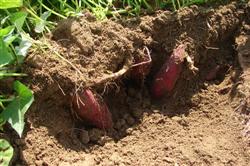What problems should be paid attention to when turning over sweet potato seedlings?

First, in the case of sufficient water, there are secondary roots at the stem nodes, and the secondary roots can absorb a large amount of nutrients and water, so that the vegetative growth is exuberant, the vines grow excessively, and the reproductive growth is inhibited, and the potato grows slowly. At the same time, the secondary root will also grow small potato pieces, resulting in a lack of nutrients, resulting in "everyone does not have enough to eat" phenomenon, resulting in low sweet potato yield. In this case, sweet potato vines should be turned frequently to control the formation of secondary roots and inhibit overgrowth, so as to provide more nutrients for reproductive growth and make potato pieces grow rapidly. Second, in the case of drought and water shortage, it is necessary to turn the sweet potato vines less or not, so that the secondary roots at the stem nodes can be formed, so as to provide more water and nutrients for plant growth, which is conducive to plant growth and survival. Otherwise, it is not conducive to the growth and survival of plants, and the yield of sweet potatoes will be reduced.
- Prev

The high yield of sweet potato depends on fertilization.
The demand of sweet potato for nitrogen, phosphorus and potassium varies with different growth stages. Nitrogen fertilizer was absorbed more in stem and leaf growth period, less in root expansion period, less in stem and leaf growth stage, and more in root expansion period, while potassium fertilizer was absorbed more than nitrogen and phosphorus from planting to harvest.
- Next

How to grow high quality radish
This is how high-quality radishes are planted these days. Zhang Yiming of Jianguo Village, Qiancao Street, Jiangyang District, Luzhou City, smiles every day. He planted more than 1 mu of high-quality long white radish varieties from South Korea last winter. In just two months, now he has to sell hundreds of jin, sometimes thousands of jin every day. He made a rough plan.
Related
- Where is it suitable to grow horseradish in China? it is expected to see the middle altitude horseradish in Alishan.
- How to prevent tomato virus disease reasonably? (Control methods included)
- Many people like to plant towel gourd on the balcony. What are the main points of this method and management?
- What crops can chili peppers be mixed with?
- Fertilization techniques and matters needing attention in Tomato
- What are the grafting techniques for peach seedlings in spring?
- Harm and control methods of root swelling disease of Chinese cabbage
- What are the pests of sweet potatoes? How to prevent and cure it?
- Symptoms, causes and Control methods of navel Rot in Tomato
- The cause of "Cucumber rotten bibcock" in Farmers' planting Cucumber and its Control Plan

